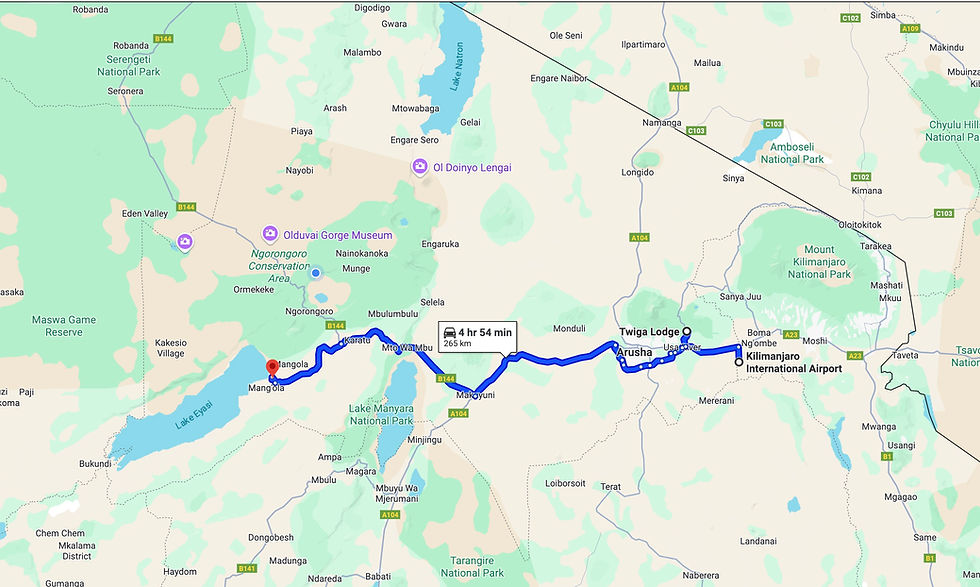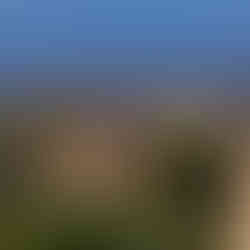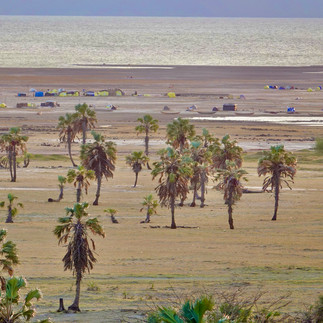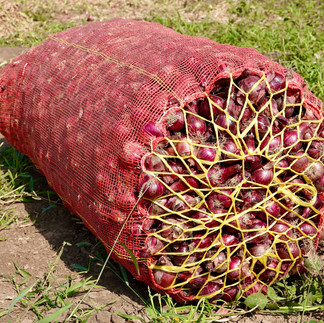Lake Eyasi
- Jan Dehn

- Jun 20
- 6 min read
Updated: Jun 21

Of the 184 countries and territories I have visited so far, Tanzania is my favourite, because Tanzania has the best nature in the world.
Tanzania also happens to be a very stable country with exceptionally polite and friendly people. I spent formative years going to school in Dar es Salaam and have since been back here many times out of sheer love for this country.
Kilimanjaro International Airport, located halfway between Arusha and Moshi, has had a make-over since the last visit in 2019. The building is beautiful and customs and immigration proves to be a breeze. Big smiles from the immigration officer, when I address her in my broken Kiswahili and tell her I used to live here. “Karibu!”, she says, and I reply “Asante sana, mama!”

We spend the first night at Twiga Lodge, a lovely park-like property owned by Paul and Erika Shaw. Paul, who is my age, a former welder, and keen birder makes very life-like statuettes of Kingfishers and other species of birds using discarded cutlery.

Paul and Erika own Shaw Safaris, a tour company, which designs bespoke trips all over East Africa for overseas clients. Expat tour operators no longer glorify colonialism, but many still sell the safari experience based on the culture of colonialism. Not so Paul and Erika. They have a refreshingly modern perspective on working and living in Africa and have made it work. They believe a business is best run by treating people with respect, providing reliable working conditions, and paying good people what they are worth. I agree with their approach whole-heartedly; this is how good businesses are run regardless of where you are.
Twiga Lodge is just a stone’s throw from the entrance gate to Arusha National Park, on the slopes of Mount Meru. My father climbed Mount Meru in the early 1970s, winning a race to the top. I always think of him when I see the peak, which just happens to be visible above the cloud from the terrace of Twiga Lodge’s lovely guest house as we sit down for a pre-dinner drink.

While one of the joys of returning to Tanzania is to revisit old haunts, this trip is also about new destinations of which Lake Eyasi is one. The next morning, refreshed after a peaceful night’s sleep in Mount Meru’s cool mountain air, we are ready to press on. Peter, a young Tanzanian with a serious disposition and a warm glint in his eyes, gives us our obligatory car briefing. Then we bid farewell to our hosts and set off.

The first stop is Rotterdam Garden, a small shopping mall in Usa River, where we stock up on tasty small Tanzanian bananas, water, dried dates, and grapes for the trip ahead. Usa River, too, brings forth memories; my whole family lived here for a time many years ago when my parents were training for their posting with the Danish Volunteer Service.
From Usa River, the road to Lake Eyasi takes us along the bypass road south of Arusha. We pass fields of maize. At the end of each field, there are placards advertising which genetically-modified type of corn is grown there. Judging by the size and colour of the maize, I would say Tanzania is undergoing a bit of a green revolution.
We continue west, stopping for a coke and a coffee at Mto wa Mbu, a town near the entrance to the Lake Manyara National Park. The waters of Lake Manyara and many other Rift Valley crater lakes (though not Lake Eyasi) have risen sharply in recent years. In Lake Manyara, the waters have risen so much that trees along the bank have become submerged and died; their black trunks now stick out of the water like the surviving hairs on a long-discarded brush. Several lodges have been submerged too, including one we stayed at on our last visit to the park. Millions have been lost. It is not even possible to drive a circuit in the park any longer as only the most elevated road through the forest is above water.

We continue westwards. Lake Eyasi is located some 50 kms west of Lake Manyara and 30 kms south of Ngorongoro. Because the main road connecting Arusha to Serengeti splits away from the Eyasi road shortly after Lake Manyara only a few visitors bother to make the detour to Eyasi.
Which is a mistake.
Lake Eyasi is well worth a visit. It is a large narrow lake stretching some 91 kms in a north-south direction. Its waters are shallow and rich in salts, so much so that fish, which enter the lake from the surrounding rivers die when the lake waters ebb and get more toxic. Since fishing is unreliable, the local population are pastoralists and farmers, while fishermen migrate here from Lake Victoria only when the waters are high. They catch a little species of fish, which they dry in the sun, mill, and sell as chicken feed.

A small number of lodges can be found near the north-eastern corner of Lake Eyasi. We stay at one of them, the Ziwani Lodge. Ziwa means lake, adding the ‘ni’ at the end changes the word into a verb. Make sense of that. Anyway, the lodge is gorgeous. It is built in Arab-Swahili style with beautiful white-washed walls, pleasing symmetries, open spaces, high ceilings, and plenty of natural ventilation.
Ziwani Lodge (Source: own photos)
The views from the rooftop over Lake Eyasi are hard to beat. The bush surrounding the lodge brims with bird life.
Ziwani Lodge views and bird life (Source: own photos)
When we first approached Lake Eyasi, it was impossible not to notice how it got drier. I was therefore surprised to see so many people living in the area and that it was so heavily farmed. The reason: rural electrification. In 2015, Tanesco, the national electricity company, connected the Eyasi region to the national grid, enabling farmers in this semi-arid region to use pumps to raise the groundwater. Vast swathes of Eyasi’s eastern hinterland, formerly bush, have since been turned into onion fields. Lake Eyasi’s red onions are highly sought after due to their exceptional quality and are now sold all over East Africa.
Paid a Dollar a day for harvesting delicious onions (Source: own photos)
The success of onion farming has positively impacted the good people of Lake Eyasi. We learn how by visiting an onion farm. As you do. After the bush is cleared, the fields are carefully calibrated to allow the water from the pumps to trickle along shallow canals into rectangular patches measuring some 4 meters by 5 meters. Agricultural workers now toil in these patches under the sun, harvesting the onions for 400 shillings, or 13 cents, per patch. A productive worker can do maybe 5 or 6 patches per day, so stands to make about a Dollar for day’s work. The workers are particular about whom they will work for; the ones we spoke to were happy with the salary, because the owner of the land supplies them with transportation to and from home, drinking water, and a meal each day; their lot, they say, is far better than it was before the boreholes and the onions. Grateful for a Dollar a day. That is poverty for you.
Before rural electrification, the Lake Eyasi area had just a single natural spring. We go to its source, a magical place. Clear waters trickles from the ground in a balmy glade of yellow acacia and tamarind trees. The waters form a little stream, which spills into a swamp with rich green reeds and a resident python, which occasionally takes a goat. Baboons and vervet monkeys hang out in the trees and locals go here when souls need solace. There are bee hives hanging from branches and birds everywhere, enjoying the proximity of water, the protection of the bush, and plenty of food. Kingfishers sit on the low branches and other vantage points looking for little fish to eat.

Our last stop is the lake itself. The lake shore is crusty with salt, but there is soft sticky mud just underneath the surface. Abandoned plastic tents on the beach flap in wind. Boats line the shore. The fishermen have departed due to the low water level.

Flamingos filter the salty waters and gulls rest on volcanic stones tossed here by the eruption that created the Ngorongoro Crater back in the day. As I approach the birds take flight. A bit up from the shore, in small bushes and candelabra trees, there are African Grey Hornbills with black beaks and a white line across the skull.
Birds along the lake (Source: own photos)
We head back to Ziwani lodge to nap through the hottest part of the day. Tonight awaits a sundowner followed by a mouth-watering Swahili meal.
Life is good.
The End


































Comments